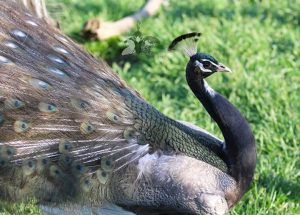
Bronze peacocks are often considered one of the most beautiful birds in the world. With their long, graceful necks, elaborate crests, and iridescent feathers, they possess an aura of elegance and splendor.
The males, known as peacocks, are particularly striking with their vividly colored tail feathers, which they display during courtship rituals. The females, referred to as peahens, have a more understated appearance but are equally captivating in their own right.
Natural Habitat and Distribution
Bronze peacocks are native to the Indian subcontinent and are found in countries such as India, Sri Lanka, and Pakistan. They primarily inhabit forests, woodlands, and grasslands, where they can find an abundance of food and suitable nesting sites. However, due to their captivating beauty, they have been introduced to various parts of the world as ornamental birds.
Physical Characteristics
Adult bronze peacocks are large birds, measuring approximately 100 to 125 centimeters (39 to 49 inches) in length, including their stunning tail feathers.
They have a robust build with a weight ranging from 4 to 6 kilograms (8.8 to 13.2 pounds). Their bodies are adorned with a combination of metallic bronze, blue, and green feathers, creating a mesmerizing visual effect.
Coloration and Plumage
The vibrant coloration of bronze peacocks is a result of light interference caused by the microscopic structure of their feathers. When light hits the feathers, it undergoes scattering and interference, producing different wavelengths and colors.
This phenomenon, known as structural coloration, gives the feathers their distinctive hues, ranging from deep blues and greens to warm bronzes and coppers.
The Courtship Display
During the breeding season, male bronze peacocks engage in a captivating courtship display to attract females. With their magnificent tail feathers spread wide, they create a breathtaking fan-shaped display known as a “train.” The train, which can measure up to 1.5 meters (5 feet) in length, is adorned with vibrant eye-like patterns called “ocelli.” The male performs a dance, shaking and vibrating his feathers while emitting low-frequency vocalizations to capture the attention of peahens.
Symbolism and Cultural Significance
Bronze peacocks hold great symbolism and cultural significance in many societies. In Hinduism, peacocks are associated with deities such as Lord Krishna and Goddess Saraswati, representing beauty, compassion, and wisdom. In other cultures, they symbolize immortality, royalty, and spirituality. Their regal appearance and enchanting displays have made them a popular motif in art, literature, and fashion.
Conservation Status and Threats
Bronze peacocks are currently listed as a species of “Least Concern” on the IUCN Red List. However, their populations are declining due to habitat loss, illegal hunting, and the pet trade.
Deforestation and urbanization have resulted in the destruction of their natural habitats, limiting their breeding and foraging grounds. Efforts are being made to protect and conserve their habitats, raise awareness, and combat illegal trade.
Captive Breeding Programs
To ensure the preservation of bronze peacocks, various zoos, conservation organizations, and aviculturalists participate in captive breeding programs. These programs aim to maintain genetically diverse populations, educate the public about the importance of conservation, and potentially reintroduce individuals into the wild.
By carefully managing breeding pairs and providing optimal care, these initiatives contribute to the long-term survival of the species.
Bronze Peacocks as Pets
The allure of bronze peacocks has led some individuals to keep them as pets. However, it is essential to understand that they require specialized care and a suitable environment to thrive.
Bronze peacocks need ample space to roam, access to a balanced diet, and appropriate shelter. Additionally, potential owners should research local regulations and consider the commitment required to provide for the bird’s welfare.
Feeding and Care
In captivity, bronze peacocks should be provided with a varied diet consisting of high-quality grains, seeds, fruits, and vegetables. They also require access to clean water for drinking and bathing.
Adequate housing should be provided, including secure enclosures to protect them from predators and harsh weather conditions. Regular veterinary check-ups are essential to monitor their health and address any concerns promptly.
Breeding and Reproduction
Breeding bronze peacocks can be a rewarding experience, but it requires careful planning and preparation. The birds should be provided with suitable nesting areas, such as dense shrubs or trees, where they can lay their eggs.
Incubation typically lasts around 28 days, after which the chicks hatch. During this time, the parents should be monitored to ensure successful hatching and proper care of the offspring.
Common Health Issues
Like any living creature, bronze peacocks are susceptible to certain health issues. Some common ailments include respiratory infections, parasites, and nutritional deficiencies. Regular observation, a balanced diet, and prompt veterinary attention can help prevent and treat these conditions.
It is crucial to consult a qualified avian veterinarian for guidance on maintaining the health and well-being of these magnificent birds.
Conclusion
Bronze peacocks are extraordinary creatures that captivate us with their stunning appearance, mesmerizing courtship displays, and rich symbolism.
As we admire their beauty, it is crucial to recognize the importance of conservation efforts to protect their natural habitats and ensure their survival for future generations.
By valuing and preserving these remarkable birds, we contribute to the preservation of biodiversity and the appreciation of nature’s wonders.
FAQs
Can bronze peacocks fly?
Yes, bronze peacocks can fly, but they are not strong fliers. They primarily use their wings for short bursts of flight and to escape predators.
How long do bronze peacocks live?
In the wild, bronze peacocks have an average lifespan of 15 to 20 years. However, under favorable conditions in captivity, they can live up to 25 years or more.
Are bronze peacocks aggressive?
Bronze peacocks are generally not aggressive toward humans. However, during the breeding season, males can become territorial and display